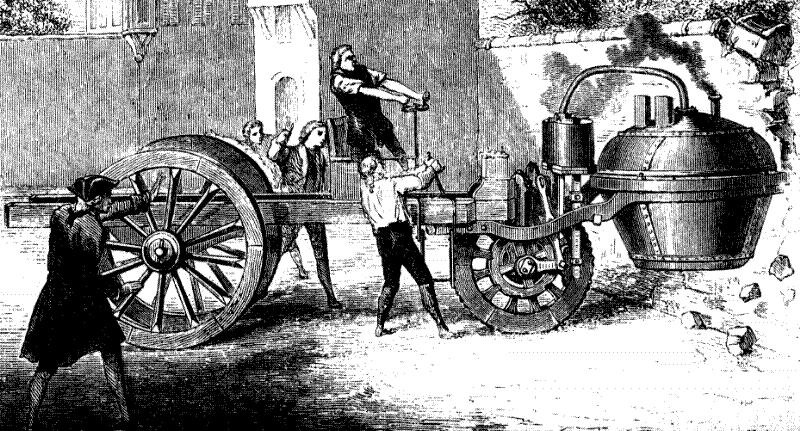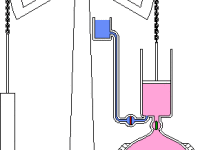
Nicholas-Joseph Cugnot’s vehicle, depicted at the famous first road accident at the Arsenal in 1770
On September 25, 1725, French inventor Nicholas-Joseph Cugnot was born. He is known to have built the first working self-propelled mechanical vehicle, the world’s first automobile.
Nicholas-Joseph Cugnot’s Self Driving Vehicle
Nicholas-Joseph Cugnot was born in Void-Vacon, Lorraine in 1725 and was trained as a military engineer. Cugnot was commissioned by the French War Ministry to develop a means of transport for the artillery. The steam engine based transport car developed by Cugnot was presented in Paris in 1769. The vehicle had two cylinders, the piston rods of which rotated the front wheel via a kind of freewheel gearbox. The car was 725 cm long, 230 cm wide, 210 cm high and weighed 4000 kg. Cugnot’s vehicle worked but needed to stop every 10 – 12 minutes to rebuild enough steam pressure to continue. The car reached a speed of between 3 and 4.5 km/h according to various statements. However, it was difficult to steer because of the high weight of the water boiler hanging over the front axle and ended one of its first demonstrations in a barracks wall.
Forerunner of the Automobile
In spite of the imperfection of the drive and control, it was the first automobile to be testified with the steam engine as drive (self-propelled car), i.e. the first car that was moved neither by humans, nor by animals, nor by the wind as external force. Previously there were only wind wagons, which depended on an external force during the journey, or quite isolated vehicles, which were moved by people sitting on them with cranks or wheels. Around 1670 the Belgian Ferdinand Verbiest had invented a small steam engine in China, which could possibly already be driven by himself.[5]
The second Prototype
However, the vehicle was reported to have been very unstable due to poor weight distribution. Therefore, a second vehicle was constructed, which is said to have gone out of control and knocked down part of the Arsenal wall. This incident became known as (possibly) the first automobile accident. However, the sources on the date of the incident differ. Cugnot had been encouraged in his work by the General Gribeauval and the Duke of Choiseul, who were placed very well at the Court of Louis XV. Gribeauval then wrote to the Marquis de Monteynard, the Minister for the War asking him to close the Avenue of Versailles so that Cugnot’s vehicle could be tested in secrecy and on uneven land. These tests most likely did not take place as the letter was never answered. It is thought the vehicle was used in the grounds of the Arsenal where it had been built.[4] Also, a big weakness of the vehicle was its boiler performance, since the fire needed to be relit and the steam raised again every quarter of an hour or so, considerably reducing overall speed.

Cugnot’s 1770 fardier à vapeur, as preserved at the Musée des Arts et Métiers, Paris
Probably too Early for its Time
After several trials, the project was abandoned by the French Army. Nevertheless, the development was so impressive that King Louis XV Cugnot suspended a pension of 600 Livres a year for his development work. Cugnot’s steam car can also be regarded as the forerunner of the railway locomotive. However, the still very immature steam engine and the associated low power at high weight caused the interest in Cugnots wagons to go out again. The Fardier (French for cart) was first kept in the Arsenal, but then in 1800 it was taken to the Conservatoire National des Arts et Métiers, where it can be visited today. The French Revolution of 1789 led to the extinction of the pension, and the inventor went into exile in Brussels, where he lived in poverty. Shortly before his death, Napoleon Bonaparte invited him to return, a call that Nicolas-Joseph Cugnot followed to Paris, where he died on 2 October 1804. Only a few decades later with considerably improved steam engines did the age of the automobile begin, especially in England and France with steam cars.
Re-engineering Cugnot’s Vehicle
In 2010, a copy of the “fardier de Cugnot” was built by some of the pupils of the Arts et Métiers ParisTech, a French Grande école, and the city of Void-Vacon. The replica worked and proved the overall concept to be viable. It was exhibited at the Paris Motor Show and it currently visible at the native village of Cugnot, at Void-Vacon.
World’s first car crash! 1769, [7]
References and Further Reading:
- [1] Nicholas-Joseph Cugnot Biography
- [2] Nicholas Cugnot Information Website
- [3] Le fardier de Cugnot descriptif détaillé sur le site de la Société des Ingénieurs de l’Automobile (SIA).
- [4] Cugnot at 3wheelers.com
- [5] 1679–1681 – R P Verbiest’s Steam Chariot”. History of the Automobile: origin to 1900. Hergé.
- [6] Nicholas-Joseph Cugnot at Wikidata
- [7] World’s first car crash! 1769, reliantregal @ youtube
- [8] Timeline of Automotive Pioneers, via DBpedia and Wikidata






Dear author,
I think there is a typing error. It says wheers, but shouldnt it say wheels? So it must say ”had two wheels at the rear and one in front”. Otherwise very interesting text.
Kind regards,
Julia
Thanks for pointing out this typo! We have updated and extended the entire article.